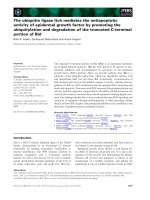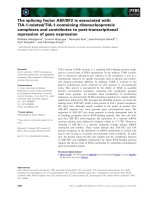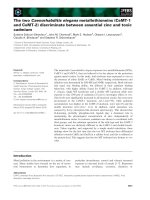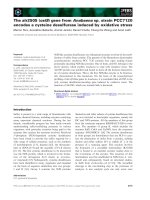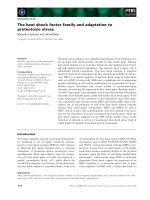Tài liệu Báo cáo khoa học: "The Linguist’s Search Engine: An Overview" ppt
Bạn đang xem bản rút gọn của tài liệu. Xem và tải ngay bản đầy đủ của tài liệu tại đây (284.16 KB, 4 trang )
Proceedings of the ACL Interactive Poster and Demonstration Sessions,
pages 33–36, Ann Arbor, June 2005.
c
2005 Association for Computational Linguistics
The Linguist’s Search Engine: An Overview
Philip Resnik Aaron Elkiss
Department of Linguistics and UMIACS UMIACS
University of Maryland University of Maryland
College Park, MD 20742 College Park, MD 20742
Abstract
The Linguist’s Search Engine (LSE) was
designed to provide an intuitive, easy-to-
use interface that enables language re-
searchers to seek linguistically interesting
examples on the Web, based on syntactic
and lexical criteria. We briefly describe
its user interface and architecture, as well
as recent developments that include LSE
search capabilities for Chinese.
1 Introduction
The idea for the Linguist’s Search Engine origi-
nated in a simple frustration shared by many peo-
ple who study language: the fact that so much of
the argumentation in linguistic theory is based on
subjective judgments. Who among us has not, in
some talk or class, heard an argument based on a
“starred” (deemed-ungrammatical) example, and
whispered to someone nearby, Did that sound ok to
you? because we thought it sounded fine? As Bard
et al. (1996) put it, each linguistic judgment is a
“small and imperfect experiment'”. Schütze (1996)
and Cowart (1997) provide detailed discussion of
instability and unreliability in such informal
methods, which can lead to biased or even
misleading results.
Recent work on linguistics methodology draws
on the perception literature in psychology to
provide principled methods for eliciting gradient,
rather than discrete, linguistic judgments (Sorace
and Keller, 2005). In addition, at least as far back
as Rich Pito’s 1992 tgrep, distributed with the
Penn Treebank, computationally sophisticated
linguists have had the option of looking at
naturally occurring data rather than relying on
constructed sentences and introspective judgments
(e.g., Christ, 1994; Corley et al., 2001; Blaheta,
2002; Kehoe and Renouf 2002; König and Lezius,
2002; Fletcher 2002; Kilgarriff 2003).
Unfortunately, many linguists are unwilling to
invest in psycholinguistic methods, or in the
computational skills necessary for working with
corpus search tools. A variety of people interested
in language have moved in the direction of using
Web search engines such as Google as a source of
naturally occurring data, but conventional search
engines do not provide the mechanisms needed to
perform many of the simplest linguistically
informed searches – e.g., seeking instances of a
particular verb used only intransitively.
The Linguist’s Search Engine (LSE) was
designed to provide the broadest possible range of
users with an intuitive, linguistically sophisticated
but user-friendly way to search the Web for
naturally occurring data. Section 2 lays out the
LSE’s basic interface concepts via several
illustrative examples. Section 3 discusses its
architecture and implementation. Section 4
discusses the current status of the LSE and recent
developments.
2 LSE Interface Concepts
The design of the LSE was guided by a simple
basic premise: a tool can’t be a success unless
people use it. This led to the following principles
in its design:
33
• Minimize learning/ramp-up time.
• Have a linguist-friendly look and feel.
• Permit rapid interaction.
• Permit large-scale searches.
• Allow searches using linguistic criteria.
Some of these principles conflict with each other.
For example, sophisticated searches are difficult to
specify in a linguist-friendly way and without
requiring some learning by the user, and rapid
interaction is difficult to accomplish for Web-sized
searches.
2.1 Query By Example
The LSE adopts a strategy one can call “query by
example,” in order to provide sophisticated search
functionality without requiring the user to learn a
complex query language. For example, consider
the so-called “comparative correlative”
construction (Culicover and Jackendoff, 1999).
Typing the bigger the house the richer the buyer
automatically produces the analysis in Figure 1,
which can be edited with a few mouse clicks to get
the generalized structure in Figure 2, converted
with one button push into the LSE’s query lan-
guage, and then submitted in order to find other
examples of this construction, such as The higher
the rating, the lower the interest rate that must be
paid to investors; The more you bingo, the more
chances you have in the drawing; The more we
plan and prepare, the easier the transition.
Figure 1. Querying by example
Figure 2. Generalized query
Crucially, users need not learn a query language,
although advanced users can edit or create queries
directly if so desired. Nor do users need to agree
with (or even understand) the LSE's automatic
parse, in order to find sentences with parses similar
to the exemplar. Indeed, as is the case in Figure 1,
the parse need not even be entirely reasonable;
what is important is that the structure produced
when analyzing the query will be the same
structure produced via analysis of the
corresponding sentences in the corpus.
Other search features include the ability to
specify immediate versus non-immediate
dominance; the ability to negate relationships
(e.g. a VP that does not immediately dominate an
NP); the ability to specify that words should
match on all morphological forms; the ability to
match nodes based on WordNet relationships (e.g.
all descendants of a particular word sense); the
ability to save and reload queries; the ability to
download results in keyword-in-context (KWIC)
format; and the ability to apply a simple keyword-
based filter to avoid offensive results during live
demonstrations.
Results are typically returned by the LSE within
a few seconds, in a simple search-engine style
format. In addition, however, the user has rapid
access to the immediate preceding and following
contexts of returned sentences, their annotations,
and the Web page where the example occurred.
2.2 Built-In and Custom Collections
Linguistically annotating and indexing the entire
Web is beyond impractical, and therefore there is a
clear tradeoff between rapid response time and the
ability to search the Web as a whole. In order to
manage this tradeoff, the LSE provides, by default,
a built-in collection of English sentences taken
randomly from a Web-scale crawl at the Internet
34
Archive.
1
This static collection is often useful by
itself.
In order to truly search the entire Web, the LSE
permits users to define their own custom collec-
tions, piggybacking on commercial Web search
engines. Consider, as an example, a search
involving the verb titrate, which is rare enough
that it occurs only twice in a collection of millions
of sentences. Using the LSE’s “Build Custom
Collection” functionality, the user can specify that
the LSE should:
• Query Altavista to find pages containing any
morphological form of titrate
• Extract only sentences containing that verb
• Annotate and index those sentences
• Augment the collection by iterating this
process with different specifications
Doing the Altavista query and extracting, parsing,
and indexing the sentences can take some time, but
the LSE permits the user to begin searching his or
her custom collection as soon as any sentences
have been added into it. Typically dozens to
hundreds of sentences are available within a few
minutes, and a typical custom collection,
containing thousands or tens of thousands of
sentences, is completed within a few hours.
Collections can be named, saved, augmented, and
deleted.
Currently the LSE supports custom collections
built using searches on Altavista and Microsoft’s
MSN Search. It is interesting to note that the
search engines’ capabilities can be used to create
custom collections based on extralinguistic criteria;
for example, specifying pages originating only in
the .uk domain in order to increase the likelihood
of finding British usages, or specifying additional
query terms in order to bias the collection toward
particular topics or domains
.
3 Architecture and Implementation
The LSE’s design can be broken into the following
high level components:
1
The built-in LSE Web collection contains 3 million sen-
tences at the time of this writing. We estimate that it can be
increased by an order of magnitude without seriously degrad-
ing response time, and we expect to do so by the time of the
demonstration.
• User interface
• Search engine interface
• NLP annotation
• Indexing
• Search
The design is centered on a relational database that
maintains information about users, collections,
documents, and sentences, and the implementation
combines custom-written code with significant use
of off-the-shelf packages. The interface with
commercial search engines is accomplished
straightforwardly by use of the WWW::Search perl
module (currently using a custom-written variant
for MSN Search).
Natural language annotation is accomplished via
a parallel, database-centric annotation architecture
(Elkiss, 2003). A configuration specification
identifies dependencies between annotation tasks
(e.g. tokenization as a prerequisite to part-of-
speech tagging). After documents are processed to
handle markup and identify sentence boundaries,
individual sentences are loaded into a central
database that holds annotations, as well as
information about which sentences remain to be
annotated. Crucially, sentences can be annotated
in parallel by task processes residing on distributed
nodes.
Indexing and search of annotations is informed
by the recent literature on semistructured data.
However, linguistic databases are unlike most
typical semistructured data sets (e.g., sets of XML
documents) in a number of respects – these include
the fact that the dataset has a very large schema
(tens of millions of distinct paths from root node to
terminal symbols), long path lengths, a need for
efficient handling of queries containing wildcards,
and a requirement that all valid results be retrieved.
On the other hand, in this application incremental
updating is not a requirement, and neither is 100%
precision: results can be overgenerated and then
filtered using a less efficient comparison tools such
as tgrep2. Currently the indexing scheme follows
ViST (Wang et al., 2003), an approach based on
suffix trees that indexes structure and content
together. The variant implemented in the LSE
ignores insufficiently selective query branches, and
achieves more efficient search by modifying the
ordering within the structural index, creating an in-
memory tree for the query, ordering processing of
35
query branches from most to least selective, and
memoizing query subtree matches.
4 Status and Recent Developments
The LSE “went live” on January 20, 2004 and
approximately 1000 people have registered and
tried at least one query. In response to a recent
survey, several dozen LSE users reported having
tried it more than casually, and there are a dozen or
so reports of the LSE having proven useful in real
work, either for research or as a tool that was
useful in teaching. Resnik et al. (2005) describe
two pieces of mainstream linguistics research –
one in psycholinguistics and one in theoretical
syntax – in which the LSE played a pivotal role.
The LSE software is currently being
documented and packaged up, for an intended
open-source release.
2
In addition to continuing
linguistic research with the LSE, we are also
experimenting with alternative indexing/search
schemes. Finally, we are engaged in a project
adapting the LSE for use in language pedagogy –
specifically, as a tool assisting language teaching
specialists in creating training and testing materials
for learners of Chinese. For that purpose, we are
experimenting with a built-in collection of Chinese
Web documents that includes links to their English
translations (Resnik and Smith, 2003).
Acknowledgments
This work has received support from the National Science
Foundation under ITR grant IIS01130641, and from the Cen-
ter for the Advanced Study of Language under TTO32. The
authors are grateful to Christiane Fellbaum and Mari Broman
Olsen for collaboration and discussions; to Rafi Khan, Sau-
rabh Khandelwal, Jesse Metcalf-Burton, G. Craig Murray,
Usama Soltan, and James Wren for their contributions to LSE
development; and to Doug Rohde, Eugene Charniak, Adwait
Ratnaparkhi, Dekang Lin, UPenn’s XTAG group, Princeton’s
WordNet project, and untold others for software components
used in this work.
References
Bard, E.G., Robertson, D. and A. Sorace. Magnitude
estimation of linguistic acceptability. Language
72.1: 32-68, 1996.
2
Documentation maintained at
Christ, Oli. A modular and flexible architecture for an
integrated corpus query system, COMPLEX'94, Bu-
dapest, 1994.
Corley, Steffan, Martin Corley, Frank Keller, Matthew
W. Crocker, and Shari Trewin. Finding Syntactic
Structure in Unparsed Corpora: The Gsearch Corpus
Query System, Computers and the Humanities, 35:2,
81-94, 2001.
Cowart, Wayne. Experimental Syntax: Applying Objec-
tive Methods to Sentence Judgments, Sage Publica-
tions, Thousand Oaks, CA, 1997.
Culicover, Peter and Ray Jackendoff. The view from
the periphery: the English comparative correlative.
Linguistic Inquiry 30:543-71, 1999.
Elkiss, Aaron. A Scalable Architecture for Linguistic
Annotation. Computer Science Undergraduate Hon-
ors Thesis. University of Maryland. May 2003.
Fletcher, William. Making the Web More Useful as a
Source for Linguistic Corpora, North American
Symposium on Corpus Linguistics, 2002.
Kehoe, Andrew and Antoinette Renouf, WebCorp: Ap-
plying the Web to linguistics and linguistics to the
Web, in Proceedings of WWW2002, Honolulu, Ha-
waii, 7-11 May 2002.
Adam Kilgarriff, Roger Evans, Rob Koeling, David
Tugwell. WASPBENCH: a lexicographer's work-
bench incorporating state-of-the-art word sense dis-
ambiguation. Proceedings of EACL 2003, 211-214,
2003.
Koenig, Esther and Lezius, Wolfgang, A description
language for syntactically annotated corpora. In:
Proceedings of the COLING Conference, pp. 1056-
1060, Saarbruecken, Germany, 2002.
Schuetze, Carson. The Empirical Base of Linguistics,
University of Chicago Press, 1996.
Sorace, Antonella and Frank Keller. Gradience in Lin-
guistic Data. To appear in Lingua, 2005.
Philip Resnik and Noah A. Smith, The Web as a Parallel
Corpus, Computational Linguistics 29(3), pp. 349-
380, September 2003.
Philip Resnik, Aaron Elkiss, Ellen Lau, and Heather
Taylor. The Web in Theoretical Linguistics Re-
search: Two Case Studies Using the Linguist's Search
Engine. 31st Meeting of the Berkeley Linguistics So-
ciety, February 2005.
H Wang, S Park, W Fan, and P Yu. ViST: a dynamic
index method for querying XML data by tree struc-
tures. ACM SIGMOD 2003. pp. 110-121.
36



